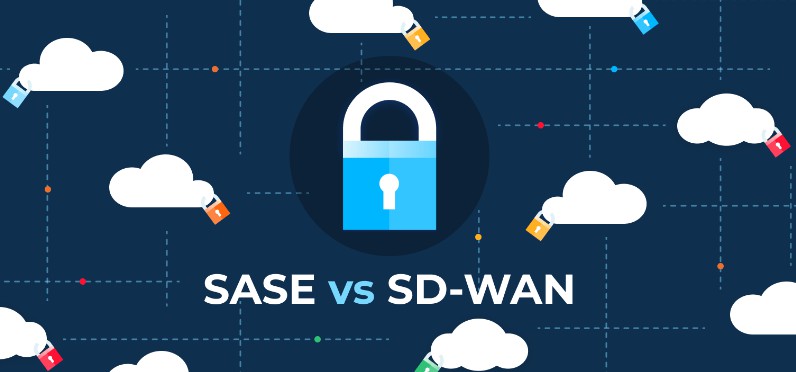Global IT supply chain
International transportation + IT O&M outsourcing + self-owned backbone network
In today’s rapidly evolving information technology landscape, SASE (Secure Access Service Edge) and SD-WAN (Software-Defined Wide Area Network) stand out as two critical technologies in modern network architecture, garnering widespread attention and adoption. SASE is an integrated framework that combines network connectivity with security services, while SD-WAN optimizes WAN management and traffic control through software-defined techniques. Although they address network and security challenges at different levels, there are significant similarities and differences between the two. This article provides an in-depth analysis and comparison of these technologies.

SASE’s Core Principles
SASE’s central concept lies in deeply integrating network architecture with security functions, delivered via the cloud. This model aims to offer enterprises a unified security access solution tailored for diverse users and devices. By tightly coupling network traffic with security technologies, SASE ensures a seamless user experience while safeguarding data. This approach is particularly crucial in the context of the growing prevalence of remote work and cloud computing, as businesses increasingly rely on remote access and cloud services.
SD-WAN’s Focus on Performance Optimization
On the other hand, SD-WAN primarily focuses on optimizing WAN performance. Utilizing software-defined technology, SD-WAN intelligently and dynamically selects the best data transmission paths, thereby enhancing overall network efficiency. It enables businesses to use multiple Internet connections, selecting the most suitable routes for data transmission, which improves bandwidth utilization and reduces latency. SD-WAN’s adaptability to various types of traffic ensures that enterprise networks can meet ever-changing business demands.
Architectural Differences
The architectural differences between the two are particularly evident. SASE, as a comprehensive solution, not only addresses network connectivity but also incorporates robust security policies. Through authentication, data encryption, and access control, SASE ensures the security of users and applications. This design is especially suited to the security needs of modern enterprises, particularly in distributed and cloud-centric environments.
In contrast, SD-WAN primarily targets network performance and availability. While it can integrate certain security features, its primary focus remains on optimizing data transmission, reducing latency, and controlling costs. SD-WAN is typically used in conjunction with other security products to create a comprehensive security solution. For instance, enterprises might combine SD-WAN with firewalls or intrusion detection systems to enhance overall network security.
Cost Implications
There are also differences in implementation and maintenance costs between SASE and SD-WAN. Since SASE integrates both network and security functions, enterprises may face higher initial investments during deployment. However, this integration offers the long-term benefit of reduced maintenance costs, as a unified management platform allows businesses to simplify the complexity of managing multiple security products.
Conversely, SD-WAN typically has lower deployment costs because it focuses primarily on network optimization. Businesses can flexibly choose different vendors based on their needs and easily integrate with existing network architectures. Although this may result in short-term cost savings, achieving comprehensive security protection may still require additional investments in other security tools and solutions.
Adaptability and Security
In terms of adaptability, SASE demonstrates greater flexibility, offering superior security protection in distributed and dynamic environments. For employees requiring remote access, SASE can provide secure connections worldwide, allowing enterprise networks to excel in complex application scenarios. SD-WAN, however, is better suited to traditional network environments and has relatively weaker remote access support capabilities. It often requires collaboration with other tools to achieve a complete solution.
From a security performance perspective, SASE offers stronger real-time monitoring and response capabilities through cloud platforms. Centralized security management enables SASE to promptly address potential security threats, ensuring real-time protection of data and networks. Since SD-WAN primarily focuses on network traffic management, its security performance typically relies on other independent security tools. While SD-WAN offers basic security features such as encryption and authentication, it may fall short of meeting the high demands of modern enterprises for comprehensive security.
In summary, both SASE and SD-WAN have distinct advantages in network management and security, with some overlap in certain areas. SASE is more suitable for enterprise environments requiring high security and flexible connectivity, while SD-WAN is ideal for organizations focusing on network performance and cost efficiency. Choosing the right solution based on an enterprise’s specific needs will help achieve the desired outcomes. For more information, feel free to consult Ogcloud Network Services.

International transportation + IT O&M outsourcing + self-owned backbone network

Cellular chips + overseas GPS + global acceleration network

Overseas server room nodes + dedicated lines + global acceleration network

Global acceleration network + self-developed patented technology + easy linking

Global Acceleration Network + Global Multi-Node + Cloud Network Integration


